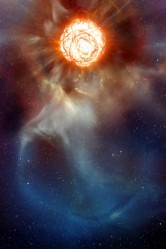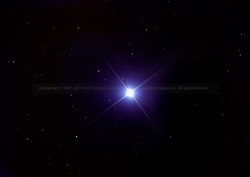Come on Betelguese, explode already. Or maybe it’ll be Eta Carinae. Which of the billions of stars in the galaxy can we count on to explode next, and when?
When a new supernova is discovered, we can take that as a reminder that we live in a terribly hostile Universe. Sometimes stars just explode, and devastate a corner of a galaxy. On average, a supernova goes off twice a century in a galaxy the size of the Milky Way. Since there are potentially hundreds of billions of galaxies out there, dozens of supernovae are detonating every second in the observable Universe.
The last bright supernova was SN 1987A, located in the Large Magellanic Cloud, about 168,000 light years away. Even though it was far, it exploded with so much energy it was visible to the unaided eye. That one wasn’t even in our galaxy.
The Milky Way’s most recent supernova that we know of was G1.9+0.3, recently confirmed by the Chandra X-Ray Observatory. It would have been visible from Earth about 100 years ago, but it was located in the dusty regions of the Milky Way and obscured from our view.
The last bright supernova was discovered in 1604 by the astronomer Johannes Kepler. This was a naked-eye supernova, in fact, at its peak, it was brighter than any other star in the night sky and for a few weeks it was even visible during the day.
So, which star is likely to explode next? Can we even know that?

We can, and there are even likely candidates. There’s Betelgeuse, the red supergiant star located in the constellation of Orion, only 640 light-years from Earth. Betelgeuse is massive, and it’s only been around for 10 million years. It will likely explode within a million years. Which, in astronomical time, is just before lunch.
Another candidate is Eta Carinae, located about 8,000 light years from us. This blue supergiant has roughly 120 times the mass of the Sun, and it’s ready to explode in the next few hundred thousand years. Which, from the Universe’s perspective is any moment now.
The closest star that could go supernova is most likely Spica, a short 240 light-years from Earth.
Spica has several times the mass of the Sun, it shouldn’t go off for a few million years yet. According to Phil Plait, the Bad Astronomer, another candidate is the star IK Pegasus A at just 150 light-years away.

If any of these supernovae do go off, they’ll be incredibly bright. Supernova Betelgeuse would be visible during the day, it might even brighter than the full Moon. It would shine in the sky for weeks, possibly months before fading away.
These explosions are destructive, releasing a torrent of gamma radiation and high energy particles. Fortunately for us, we’re safe. You’d need to be within about 75 light years to really receive a lethal dose. Which means that even the closest supernova candidate is still too far to cause us any real harm.
Which star is set to explode next? Well, in the last second, 30 supernovae just went off, somewhere in the Universe. Here in our galaxy, there should be a supernova in the next 50 years or so, but we still might not be able to see it.
And if we’re really really lucky, Betelgeuse or Eta Carinae will detonate, and we’ll witness one of the most awe inspiring events in the cosmos from the safety of the front porch of our galactic suburban home. Any time now.
Which star would you like to see go supernova? Tell us in the comments below!


isn’t it possible to check for the metallicity?
I mean, if i boil water, the air in the water will form bubbles at about 80 C … its some indication as how far off the water is to boiling.
The same might go for a star, heated pockets of impurities might be “boiled” out, as a first indication, or make it look more tranquil than expected.
No, star cores are not convective (except red dwarfs). Observed metallicity originates from the gas cloud the star was born from, and thus previous generations of stars gone supernova.